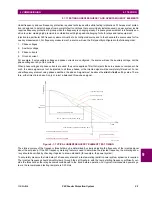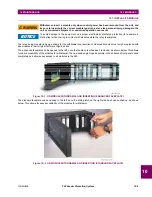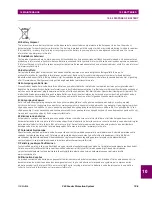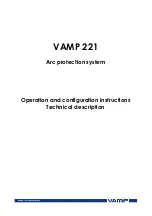
GE Multilin
F60 Feeder Protection System
8-1
8 THEORY OF OPERATION
8.1 HIGH-IMPEDANCE (HI-Z) FAULT DETECTION
8
8 THEORY OF OPERATION 8.1HIGH-IMPEDANCE (HI-Z) FAULT DETECTION
8.1.1 DESCRIPTION
The Hi-Z element accomplishes high-impedance fault detection using a variety of algorithms, all coordinated by an expert
system. At the heart of the high-impedance fault-detection system is the identification of arcing on a feeder. If the Hi-Z ele-
ment detects arcing, it then determines whether or not the arcing persists for a significant period of time. If it does, the Hi-Z
element determines whether the persistent arcing is from a downed conductor or from an intact conductor and then gener-
ates an output to indicate either the detection of a downed conductor or the detection of arcing, respectively.
Distinction between an arcing intact conductor and an arcing downed conductor is determined by looking at patterns in the
load current at the beginning of the fault. A downed conductor is indicated only when a precipitous loss of load or an over-
current condition precedes arcing detection. Otherwise, the Hi-Z element assumes that the line is intact, even if arcing is
present. In such a case, if the detected arcing can be classified as persistent, and an output contact is configured for 'arcing
detected', the Hi-Z element will close that contact.
In some cases, arcing is determined to be present, but not persistent. For example, if it is caused by tree limb contact or
insulator degradation, arcing will typically be present intermittently with relatively long periods of inactivity (e.g. minutes)
interspersed. In such cases, arcing may be affected by such factors as the motion of a tree limb or the moisture and con-
tamination on an insulator. Conditions such as these, characterized by a high number of brief occurrences of arcing over an
extended period of time (e.g. from a fraction of an hour to one or two hours), lead the Hi-Z element to recognize and flag an
“arcing suspected” event. None of these brief occurrences of arcing, if taken individually, are sufficient to indicate detection
of a downed conductor or to set off an alarm indicating that persistent arcing has been detected. When considered cumula-
tively, however, they do indicate a need for attention. If an output contact is configured to indicate 'arcing suspected', the Hi-
Z element recognition of such sporadic arcing will close that contact and appropriate actions can be taken.
If the Hi-Z element determines that a downed conductor exists, oscillography and fault data are captured. In addition, target
messages and appropriate LEDs are activated on the relay faceplate.
The detection of a downed conductor or arcing condition is accomplished through the execution of the following algorithms:
•
Energy Algorithm
•
Randomness Algorithm
•
Expert Arc Detector Algorithm
•
Load Event Detector Algorithm
•
Load Analysis Algorithm
•
Load Extraction Algorithm
•
Arc Burst Pattern Analysis Algorithm
•
Spectral Analysis Algorithm
•
Arcing-Suspected Identifier Algorithm
•
Even Harmonic Restraint Algorithm
•
Voltage Supervision Algorithm
8.1.2 ENERGY ALGORITHM
The Energy algorithm monitors a specific set of non-fundamental frequency component energies of phase and neutral cur-
rent. After establishing an average value for a given component energy, the algorithm indicates arcing if it detects a sudden,
sustained increase in the value of that component. The Hi-Z element runs the Energy algorithm on each of the following
parameters for each phase current and for the neutral:
•
even harmonics
•
odd harmonics
•
non-harmonics
On a 60 Hz system, the non-harmonic component consists of a sum of the 30, 90, 150,..., 750 Hz components, while on a
50 Hz system, it consists of a sum of the 25, 75, 125,..., 625 Hz components. If the Energy Algorithm detects a sudden,
sustained increase in one of these component energies, it reports this to the Expert Arc Detector algorithm, resets itself,
and continues to monitor for another sudden increase.
Содержание F60
Страница 10: ...x F60 Feeder Protection System GE Multilin TABLE OF CONTENTS ...
Страница 30: ...1 20 F60 Feeder Protection System GE Multilin 1 5 USING THE RELAY 1 GETTING STARTED 1 ...
Страница 138: ...4 28 F60 Feeder Protection System GE Multilin 4 2 FACEPLATE INTERFACE 4 HUMAN INTERFACES 4 ...
Страница 454: ...5 316 F60 Feeder Protection System GE Multilin 5 10 TESTING 5 SETTINGS 5 ...
Страница 500: ...7 14 F60 Feeder Protection System GE Multilin 7 1 COMMANDS 7 COMMANDS AND TARGETS 7 ...
Страница 508: ...8 8 F60 Feeder Protection System GE Multilin 8 2 FAULT LOCATOR 8 THEORY OF OPERATION 8 ...
Страница 522: ...10 12 F60 Feeder Protection System GE Multilin 10 6 DISPOSAL 10 MAINTENANCE 10 ...
Страница 660: ...B 116 F60 Feeder Protection System GE Multilin B 4 MEMORY MAPPING APPENDIX B B ...
Страница 706: ...E 10 F60 Feeder Protection System GE Multilin E 1 IEC 60870 5 104 APPENDIX E E ...
Страница 718: ...F 12 F60 Feeder Protection System GE Multilin F 2 DNP POINT LISTS APPENDIX F F ...
Страница 728: ...H 8 F60 Feeder Protection System GE Multilin H 2 ABBREVIATIONS APPENDIX H H Z Impedance Zone ...
Страница 730: ...H 10 F60 Feeder Protection System GE Multilin H 3 WARRANTY APPENDIX H H ...
















































